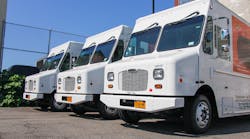Regardless of economic conditions, savvy fleets have planned replacement cycles for their assets. Failure to plan for asset replacements can lead to a rapid escalation of variable expenses which will end up in a peak-valley-peak-valley cycle that will complicate budgeting well into the future.
When economic times — like the one we are in, thanks to COVID-19 — are tough, fleets can be tempted to abandon their planned replacement cycles thinking they do not want to invest in fixed expenses at this time.
Fleets need to have is a consistent year-over-year replacement plan, but one that allows them to make incremental changes in the overall fleet makeup that targets savings. By having this flexibility, the fleet operator can increase or decrease the fleet size based on utilization.
For example, if a fleet has a growth year of 10% to 15%, it is not going to purchase assets for the full amount of growth until it has been established that it is long-term growth. Conversely, when business is down, fleets should not immediately sell-off under-utilized assets unless they know the decline is long-term.
Instead, fleets need to revisit the replacement plan they had in place to see how they can make minor adjustments. For example, if the original plan called for 100 trucks to be replaced in 2020, perhaps you only replace 90 to 95.
But this is critical: the decision about which assets to replace must be done on an asset-by-asset basis. You have to answer the question “if I am going to replace assets, which is the first one to be replaced?”
At the top of the list is the asset with the highest cost — the one that will yield the most savings if replaced. Then you start drilling down to determine where your break point is to where the savings is not necessarily enough to bring on another new truck. That could be at 90 trucks or 92 truck or some other number of the original 100 that the fleet had planned to replace.
Then you have to layer over the top of that the timing of the replacement. Is the timing of replacement more important this year than it has been in any other year? What is good timing when it comes to asset replacement? Based upon reduced utilization, can you keep an asset for an additional two-to-three months and source the new asset, so it comes into the fleet at the end of this year as business hopefully pulls out of the current economy slump? You can do this because even though the variable expenses may be high, the trucks are not accumulating a lot of miles so they will not generate a lot of additional maintenance and repair (variable) expenses.
It is also important to make sure you understand the OEMs ability to deliver vehicles when you need them. If in July you order for trucks to be delivered in December, can the OEM meet that requirement? This is where having a strong relationship with your OEM supplier can pay big dividends in ensuring you get the trucks you need when you need them.
Every fleet needs to develop a strategic replacement plan every year. History will dictate what that plan should look like. However, when economic conditions decline, the fleet can use tactical decisions to alter the plan as needed.




